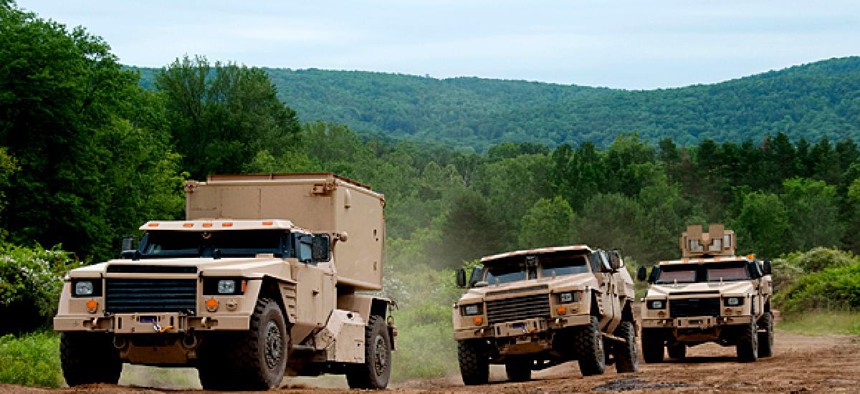Three contractors tapped to develop smart Humvee replacements

Lockheed Martin
Next-generation tactical vehicle will require a high-speed local area network to run multiple systems.
The Army and Marine Corps awarded three companies development contracts Wednesday for their next generation of wheeled tactical vehicles, which will require a gigabit speed local area network to support onboard computers, communications and electronic warfare systems.
AM General, Lockheed Martin Corp. and Oshkosh Corp. won 27-month engineering and development contracts valued at $64.5 million, $66.3 million and $56.4 million respectively to produce 22 prototype Joint Light Tactical Vehicles each. The services will evaluate the prototypes at Army test centers in Arizona, Maryland and New Mexico.
The services then will select a single contractor to manufacture up to 50,000 JLTVs for the Army and another 5,000 for the Marine Corps. The development contracts specify that the services will pay no more than $250,000 per JLTV, putting the value of the production contract for 55,000 vehicles at $13.8 billion.
The JLTV will replace the Humvee that AM General developed in 1981 with vehicles that have been designed from the ground up to deal with threats from the makeshift bombs, or improvised explosive devices, which took a heavy toll on the thin-skinned Humvees during the Afghanistan and Iraq wars. AM General has manufactured 240,000 Humvees at prices ranging from $65,000 to $140,000 for variants with added armor.
The Army and Marines want the JLTV to have a bomb-deflecting hull and enough armor to resist IED blasts. At the same time, the vehicles should be lightweight enough to be transported in the workhorse C-130 tactical airlifter or by helicopters in sling loads, the services said.
The design also calls for a built-in computers and high-speed local area network to support IED jammers, satellite and ground radios, Global Positioning System receivers, and vehicle diagnostic systems. The JLTV driver and commander will each be furnished with smart display units to manage these systems.
The JLTV systems architecture calls for the use of both Microsoft Windows and open source Linux operating systems and the Force XXI Battle Command Brigade-and-Below/Blue Force Tracking system, a Linux-based system designed to help commanders track friendly and hostile forces on a battlefield on satellite-linked digital map displays.
Security software is so integral to the operation of the JLTV that the contracts call for an information assurance strategy, including a detailed system design, a test strategy and scans of the software code library.
BAE Systems, General Dynamics and Navistar also competed for the JLTV contract; the Army tapped them in October 2008 for technology development contracts, which included tests of prototypes at the Army's Aberdeen Proving Ground in Maryland.
Spokesmen for General Dynamics and BAE Systems expressed disappointment at not winning the JLTV prototype development contract and declined further comment until they received a debriefing from the services. A Navistar spokeswoman said there may be an opportunity for the company to bid on the production contract.






